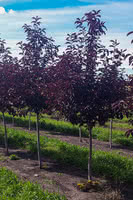Mon-Fri 9am - 5pm Mountain time
Robert Chokecherry vs Golden Spice Pear
Prunus virginiana Robert
Pyrus Golden Spice
NOT AVAILABLE THIS SEASON - MIGHT RETURN
NOT AVAILABLE THIS SEASON - MIGHT RETURN
Developed in Barrhead, Alberta, the Robert Chokecherry produces very large berries (comparable to the size of grapes) with good yield.
The berries can be used for wine, jams, jellies and fresh picking, making it one of the sweeter chokecherries. Rich, red foliage make it a striking landscape addition.
Golden Spice Pear produces delicious fruit and has other features that make it a striking accent tree. It is one of the few pears that successfully grows on the Canadian prairies. In late August, small, yellow pears with a slight red overlay will ripen and be ready for a variety of needs, including: fresh eating, canning, jams, and baking. They are slightly sweet with a crisp texture. Come fall, the green foliage transitions to orange, red, or burgundy, adding a burst of color to your yard.
Golden Spice Pear requires upkeep to ensure its survival and longevity. Regular pruning is recommended in late winter or early spring to maintain the oval shape and overall health of the tree. An additional pear or apple tree is required within 150 m (500’) for cross pollination and fruit production to occur.
Robert Chokecherry Quick Facts
Golden Spice Pear Quick Facts
Toxicity: Toxic to animals with segmented stomachs (horses, cattle, deer moose, etc.)

